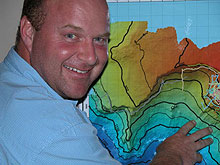
Dr. Tim Shank, Marine Biologist. Image courtesy of NOAA.
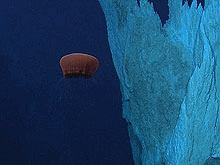
Hercules captured this video of a deep-sea jelly fish, possibly Poralia rufescens, undulating several meters above the seafloor just south of the IMAX vent at Lost City.
![]() Click image to view a slide show and
image credit.
Click image to view a slide show and
image credit.
![]() Aurelia Jelly
Fish undulates several meters above the seafloor. (Quicktime,
720 Kb)
Aurelia Jelly
Fish undulates several meters above the seafloor. (Quicktime,
720 Kb)
Animals of Lost City
July 27, 2005
Dr. Tim Shank
Marine Biologist
![]() Watch as the Hercules manipulator arm collects water, carbonate and organisms. (Quicktime, 1.6 Mb)
Watch as the Hercules manipulator arm collects water, carbonate and organisms. (Quicktime, 1.6 Mb)
As we explore the Lost City hydrothermal vent system, we want to learn if the animals at Lost City are unique and if the composition of the animals' communities is driven by the harsh chemical conditions (e.g. greater than pH10) of the Lost City habitats. We will collect animals living along cracks of highly sculpted and porous carbonate structures to correlate community composition with concentrations of chemicals in the venting fluids. Some of the larger organisms we've found include an Aurelia Jelly Fish, a Black Coral, and a Xenophyophore. We will also examine stable isotopic signatures of the collected fauna to assess what the animals are feeding on and their trophic relationships.
Another fundamental question we are pursuing is how novel are these animals and how have they evolved to thrive at Lost City? Using molecular genetic data we are comparing the fauna of Lost City to those that live at other hydrothermal vents and hydrocarbon seeps common along the margins of our coast. There are several factors that differentiate this environment from others. While Lost City vents are in close proximity to the Mid-Atlantic Ridge (<15 kilometers) they are at a much shallower depth (< 2000 m) and have very different fluid chemistry than the hydrothermal vents of the Mid-Atlantic Ridge. The fluid coming up through the chimneys at Lost City have a pH similar to agents used to unclog your drains. This fluid is derived from serpentinization reactions (see essay).
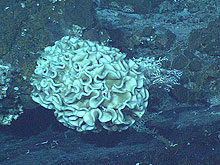
The image may be one of a large 20-cm wide Xenophyophore. Xenophyophores are single cell animals called Protists. As benthic particulate feeders, xenophyophores normally sift through the sediments on the sea floor. and excrete a slimy substance; in locations with a dense population of xenophyophores, such as at the bottoms of oceanic trenches, this slime may cover large areas. Local population densities may be as high as 2,000 individuals per 100 square meters.Click image for larger view and image credit.
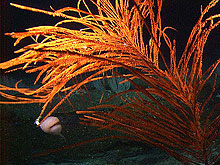
This is an antipatharian or black coral. Antipatharian corals are solitary, their six-tentacled polyps being located in a skin-like coenenchyme that surrounds the spiny, horny skeleton of this coral. These corals can often be home to many invertebrate animals. Crawling and attached to this particular specimen were tiny galatheid crabs, polychaete worms, small highly-branched hydroids, and spider crabs. Perhaps these corals are more like an apartment building rather than a single family home. Click image for larger view and image credit.
Similar carbonate systems on the seafloor may have shaped the evolution of chemosynthetic life.
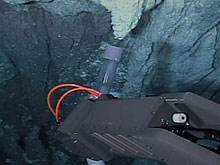
To sample animals in Lost City, we have constructed samplers for this cruise that use hydraulic suction to essentially vacuum animals from the seafloor. Much like using a vacuum cleaner in your living room, the pilot grabs the end of a retractable hose and positions the open end on the surface of a Lost City spire. The hydraulic pump is turned on and the suction begins. Pieces of carbonate and the small animals living on them get sucked into a four-liter chamber where the animals are stored until they reach the surface and taken off the vehicle for sorting. Click image for larger view and image credit.
![]() Watch
as the Hercules manipulator arm collects water, carbonate
and organisms. (Quicktime, 1.6 Mb)
Watch
as the Hercules manipulator arm collects water, carbonate
and organisms. (Quicktime, 1.6 Mb)
To sample animals in Lost City, we have constructed samplers for this cruise that use hydraulic suction to essentially vacuum animals from the seafloor. Pieces of the substrate and the organisms are sucked into storage chambers for later analyses.
Sign up for the Ocean Explorer E-mail Update List.


























